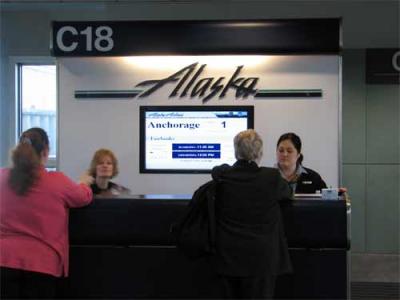Note: As a way to use this Journal, you may want to copy the journal entry into a word file and highlight the parts that you want to share with your classes.
Welcome to spring! Ever since the winter solstice on Dec 21 the amount of day light has been increasing in the northern hemisphere. On March 21 we reached the spring equinox, the suns rays were most intense at the equator and the official first day of spring.
This is a great day to take a trip! I am very excited to be going to Alaska and the SEDNAIn addition to being the acronym for this research project (Sea-ice Experiment—Dynamic Nature of the Arctic), SEDNA is also the name of the Inuit Goddess of the Sea. There are several variations of the mythological story of SEDNA, click here to read one. ice camp in the Arctic Ocean. But first, Dr. Cathy Geiger, an ice scientist, and I need to get there from White River Junction in Vermont. We went across the Connecticut River to Lebanon, NH and took a bus to Boston. At Boston’s Logan Airport we got on Alaska Airlines flight 25 to Seattle. We left Boston at 0720 and arrived at 1340 (1:40pm). Our flight covered 2496 miles.
What was our flight time and what was our speed? I expect that our return flight from Seattle to Boston will be faster and take less fuel. Why? (Warning: I wonder about a lot of things so I ask a lot of questions. It must be the science teacher in me).
As we were coming in for a landing in Seattle we broke through the clouds and could see Puget Sound and the Pacific Ocean. The Cascade Range was covered with snow, and there were beautiful trees covered with pink flowers. Seattle is at about the same latitude as White River Junction, but White River is still covered in snow and spring has arrived in Seattle. Why? The city of Seattle is named after Chief Seattle a very wise man. As I got off the plane, I noticed that our flight to Alaska was boarding at 11:30am. What’s up with that?

We were on Alaska Airlines flight 1 out of Seattle to Anchorage and then on to Fairbanks.
We left Seattle at 1200 (noon) and arrived in Anchorage at 1545 (3:45pm). The local time in Anchorage was 2:45. We had flown a distance of 1448 miles. Apparently there was a head wind on the way up. We left Anchorage at 1510 and flew 261 miles to Fairbanks. Fairbanks is on the same time as Anchorage. What time do you calculate that we arrived? The temperature was a quite reasonable 28oF. What is that temperature using the Celsius (Centigrade) scale?
Note: Scientists have troubles with time zones and dates when reporting their data for the international community so they report times using Greenwich Mean Time and dates by day/month/year. Also if you are interested in our routes of flight you can look them up at Alaskaair.com. Some other websites of interest for the SEDNAIn addition to being the acronym for this research project (Sea-ice Experiment—Dynamic Nature of the Arctic), SEDNA is also the name of the Inuit Goddess of the Sea. There are several variations of the mythological story of SEDNA, click here to read one. ice camp are:

Comments